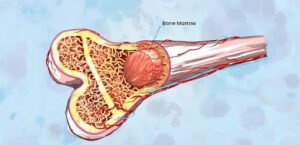What Is a Bone Marrow Transplant?
A bone marrow transplant, also known as a hematopoietic stem cell transplant, is a medical procedure that replaces damaged or diseased bone marrow with healthy stem cells. Bone marrow, the spongy tissue inside bones, produces essential blood cells needed for oxygen transport, infection control, and clotting. Stem cells within the marrow can mature into different types of blood cells like red blood cells, white blood cells, and platelets.
Bone marrow transplants are recommended when the marrow isn’t functioning properly due to conditions such as leukemia, lymphoma, aplastic anemia, or genetic disorders. There are two main types:
- Autologous Transplant: Uses the patient’s own stem cells, collected and stored before high-dose chemotherapy or radiation, then reinfused after treatment.
- Allogeneic Transplant: Uses stem cells from a compatible donor, such as a family member or an unrelated donor with a matching tissue type, offering long-term remission for some conditions.

The decision to proceed with a transplant involves a thorough evaluation of health, age, and the availability of suitable donors. Bone marrow transplants provide hope for many but come with complexities that require weighing the risks and benefits.
Why Would You Need a Bone Marrow Transplant?
A bone marrow transplant may be essential for individuals facing medical conditions that impair marrow function. Reasons include:
- Blood Cancers: Conditions like leukemia, lymphoma, and multiple myeloma disrupt marrow function, reducing healthy cell production.
- Genetic Disorders: Diseases such as sickle cell anemia, thalassemia, and aplastic anemia result in severe abnormalities in blood production due to genetic mutations. A transplant can replace faulty stem cells, allowing normal blood production.
- Autoimmune and Immune System Disorders: Diseases like severe combined immunodeficiency (SCID), systemic lupus erythematosus (SLE), and rheumatoid arthritis may necessitate a transplant to reset the immune system with new, healthy cells.
Types of Bone Marrow Transplants
Bone marrow transplants come in three main types:
- Autologous Transplant: Uses the patient’s own healthy stem cells, collected and stored before treatments like chemotherapy. This method minimizes the risk of rejection.
- Allogeneic Transplant: Uses stem cells from a matched donor, either a sibling or unrelated individual. Although it carries a higher risk of complications like graft-versus-host disease (GVHD), it may offer longer remission for conditions like leukemia.
- Umbilical Cord Blood Transplant: Utilizes stem cells from umbilical cord blood, often when no suitable adult donor is available. Though containing fewer stem cells, it has been effective in treating some blood disorders in both children and adults.
Preparing for a Bone Marrow Transplant
Preparation involves several steps to ensure a successful procedure and recovery:
- Medical Evaluation: Tests such as blood work, imaging, and assessments of cardiac and pulmonary function are conducted to evaluate health status and identify risks.
- Finding a Donor Match: For allogeneic transplants, finding a compatible donor, whether family or unrelated, is critical for success. Donors are also tested to ensure compatibility.
- Emotional and Psychological Preparation: Support from family, friends, and mental health professionals is essential. Many centers offer counseling and support groups to help patients cope emotionally.
Bone Marrow Transplant Procedure
The transplant procedure includes key stages:
- Collection of Bone Marrow: Stem cells are collected from the donor or patient, either through apheresis (blood filtration) or direct extraction from the pelvic bones.
- Preparation for Transplantation: The collected marrow is processed, often removing unwanted components to ensure only healthy cells are infused.
- Conditioning Therapy: High-dose chemotherapy or radiation is administered to make space in the recipient’s marrow for new cells.
- Transplantation: The harvested cells are infused intravenously into the bloodstream, where they migrate to the bones and begin producing new blood cells.
Bone Marrow Transplant Recovery
Recovery is critical and occurs in phases:
- Initial Hospital Recovery: Patients are closely monitored for complications, including side effects like fatigue, nausea, and mucositis. Proper rest, hydration, nutrition, and medication adherence are vital.
- Home Care: Continued monitoring is necessary as patients may still experience fatigue and weakness. Physical activity, as tolerated, helps regain strength.
- Long-Term Recovery: Patients may need lifestyle adjustments, including dietary changes and regular exercise, and regular follow-up appointments are essential for blood count monitoring and managing any late effects.

Risks of Bone Marrow Transplants
Bone marrow transplants, though life-saving, carry risks:
- Graft-Versus-Host Disease (GVHD): In allogeneic transplants, the donor’s immune cells may attack the recipient’s body, causing symptoms like rash, jaundice, and abdominal pain. Immunosuppressive medications help mitigate GVHD risk.
- Infection: Due to a weakened immune system, patients are highly susceptible to infections. Isolation and prophylactic antibiotics are used to protect against common infections.
- Organ Damage: High-dose chemotherapy and radiation can impact organs like the heart, lungs, kidneys, and liver. Regular monitoring detects early signs of organ damage, allowing timely intervention.
Bone Marrow Transplant Outlook
The outlook after a bone marrow transplant involves cautious optimism. The first 100 days are particularly critical due to the risk of complications like GVHD or infections. Success largely depends on donor compatibility, age, overall health, and absence of comorbidities.
Long-term effects may include issues like infertility, cognitive changes, secondary cancers, or organ damage. Consistent follow-up care and monitoring help manage these potential outcomes and optimize quality of life.
Takeaways
Post-transplant care is vital to recovery and includes:
- Following Medical Advice: Attend all follow-up appointments, adhere to medication regimens, and maintain a healthy lifestyle.
- Patient Resilience: Recovery varies, requiring patience and resilience. Support from healthcare providers and mental health resources can be invaluable in managing physical and emotional challenges.
A bone marrow transplant offers a chance for renewed health and hope for many, but it requires careful consideration and diligent post-transplant care to ensure the best possible outcome.